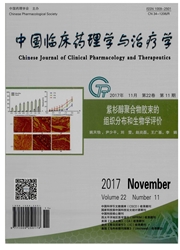

 中文摘要:
中文摘要:
目的:通过体外细胞实验,研究半胱氨酸(cysteine,CYS)加剧棕榈酸(palmitate,PAL)诱导肝细胞死亡的作用机制。方法:以人肝细胞株Hep G2为细胞模型,采用LDH、MTT技术以及Hoechst染色法检测细胞增殖活性,通过酶化学方法检测细胞内谷胱甘肽(glutathione,GSH)和丙二醛(malondialdehyde,MDA)含量,应用DCFH-DA探针检测细胞内活性氧(reactive oxygen species,ROS)水平,利用Western blot技术检测细胞内质网应激相关蛋白C/EBP同源转录因子(C/EBP homologous transcription factor,CHOP),GRP-78以及磷酸化的c-Jun氨基末端激酶(phosphorylated c-jun N-terminal kinase,p-JNK)的表达量。结果:(1)PAL可以显著抑制Hep G2细胞的增殖活性。(2)PAL提高Hep G2细胞内的GSH水平,但不影响MDA和ROS水平。(3)CYS显著加剧PAL诱导肝细胞死亡的作用。(4)CYS/PAL协同作用不影响细胞内MDA和ROS水平。(5)CYS/PAL协同作用可显著提高肝细胞内质网应激相关蛋白GRP-78、CHOP和p-JNK的表达。(6)抑制JNK通路可抑制PAL诱导的细胞死亡。结论:CYS通过激活JNK通路导致内质网应激加强,从而加剧PAL诱导细胞死亡,参与NASH发病机制。
 英文摘要:
英文摘要:
AIM: To study the mechanisms of the aggravation of palmitate-induced liver cell death caused by cysteine through vitro experiments.METHODS: The effects of cysteine inclusion on palmitate induced cell death were determined by LDH release MTT assay and Hoechst staining using human liver cells. Oxidative stress was evaluated by intracellular glutathione(GSH) level,malondialdehyde( MDA) formation and DCFH-DA assay. Western blot was performed to detect the changes of endoplasmic reticulum( ER) stress markers: C/EBP homologous transcription factor( CHOP),GRP-78,and phosphorylated c-Jun N-terminal kinase( pJNK). RESULTS:( 1) Palmitate induced Hep G2 cells death.( 2) Palmitate did not cause significant increases in intracellular MDA and ROS contents,but unexpectedly increased intracellular GSH levels.( 3) Cysteine aggravated palmitate-induced hepatocytes death.( 4) Cysteine / palmitate could not alter intracellular MDA and ROS level.( 5) Cysteine / palmitate induced significant increases in protein abundance of three ER stress markers: GRP-78,CHOP and p-JNK.( 6) Inhibition of JNK pathway prevented cytotoxicity. CONCLUSION: Cysteine enhanced ER stress by activating JNK pathway,finally leading hepatocytes to palmitate-induced cell death.
 同期刊论文项目
同期刊论文项目
 同项目期刊论文
同项目期刊论文
 期刊信息
期刊信息
